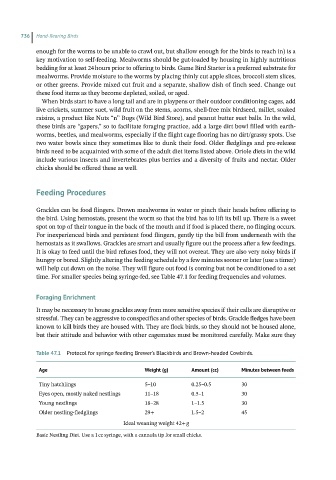Page 734 - Hand rearing birds second
P. 734
736 Hand-Rearing Birds
enough for the worms to be unable to crawl out, but shallow enough for the birds to reach in) is a
key motivation to self‐feeding. Mealworms should be gut‐loaded by housing in highly nutritious
bedding for at least 24 hours prior to offering to birds. Game Bird Starter is a preferred substrate for
mealworms. Provide moisture to the worms by placing thinly cut apple slices, broccoli stem slices,
or other greens. Provide mixed cut fruit and a separate, shallow dish of finch seed. Change out
these food items as they become depleted, soiled, or aged.
When birds start to have a long tail and are in playpens or their outdoor conditioning cages, add
live crickets, summer suet, wild fruit on the stems, acorns, shell‐free mix birdseed, millet, soaked
raisins, a product like Nuts “n” Bugs (Wild Bird Store), and peanut butter suet balls. In the wild,
these birds are “gapers,” so to facilitate foraging practice, add a large dirt bowl filled with earth-
worms, beetles, and mealworms, especially if the flight cage flooring has no dirt/grassy spots. Use
two water bowls since they sometimes like to dunk their food. Older fledglings and pre‐release
birds need to be acquainted with some of the adult diet items listed above. Oriole diets in the wild
include various insects and invertebrates plus berries and a diversity of fruits and nectar. Older
chicks should be offered these as well.
Feeding Procedures
Grackles can be food flingers. Drown mealworms in water or pinch their heads before offering to
the bird. Using hemostats, present the worm so that the bird has to lift its bill up. There is a sweet
spot on top of their tongue in the back of the mouth and if food is placed there, no flinging occurs.
For inexperienced birds and persistent food flingers, gently tip the bill from underneath with the
hemostats as it swallows. Grackles are smart and usually figure out the process after a few feedings.
It is okay to feed until the bird refuses food, they will not overeat. They are also very noisy birds if
hungry or bored. Slightly altering the feeding schedule by a few minutes sooner or later (use a timer)
will help cut down on the noise. They will figure out food is coming but not be conditioned to a set
time. For smaller species being syringe‐fed, see Table 47.1 for feeding frequencies and volumes.
Foraging Enrichment
It may be necessary to house grackles away from more sensitive species if their calls are disruptive or
stressful. They can be aggressive to conspecifics and other species of birds. Grackle fledges have been
known to kill birds they are housed with. They are flock birds, so they should not be housed alone,
but their attitude and behavior with other cagemates must be monitored carefully. Make sure they
Table 47.1 Protocol for syringe feeding Brewer’s Blackbirds and Brown-headed Cowbirds.
Age Weight (g) Amount (cc) Minutes between feeds
Tiny hatchlings 5–10 0.25–0.5 30
Eyes open, mostly naked nestlings 11–18 0.5–1 30
Young nestlings 18–28 1–1.5 30
Older nestling‐fledglings 29+ 1.5–2 45
Ideal weaning weight 42+ g
Basic Nestling Diet. Use a 1 cc syringe, with a cannula tip for small chicks.

